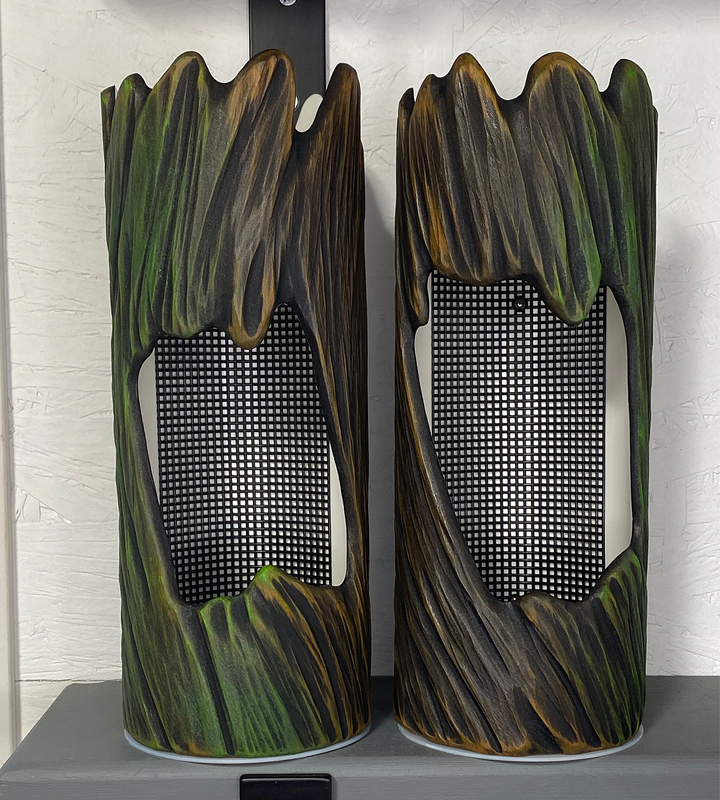Chamaeleo calyptratus - Veiled Chameleon
Veiled chameleons are a medium lizard with specific needs to thrive, and are not good beginner pets. They are a tropical, arboreal lizard and are diurnal, meaning they are active during the day. They are easily stressed so are best if left alone as a display only pet. They display a wide range of colors to regulate their temperatures and communicate with other chameleons. They are named for the distinctive casques the males have on their heads as adults.
|
Bring Home Your New Pet
When you bring your new chameleon home, you should already have a quarantine enclosure set up and ready to go. Be sure to have the setup ready ahead of time and check temperatures and basking spots for proper temps before you add your chameleon. They may not eat the first couple days, or even longer. You should keep this new pet separate from any other pets you may have for 90 days, to ensure there is nothing it could spread to your other animals. Monitor its eating and fecals as they may be strange for up to a couple weeks, but this is due to a new diet, supplements, and environment. It is recommended you do not handle your new chameleon for the first 24-48 hours and keeping it to a minimum until it has started eating on its own. Always keep in mind, your new animal is in a new tank, with new decor/dishes/hides, and new faces watching them. They need time to become acclimated to it all. After this quarantine process, they can be safely introduced to their permanent enclosure if it's not already. Be sure to wash your hands before handling any other pets during this time. |
|
Enclosure Veiled chameleons need quite a bit of space as adults. They are prone to respiratory infections if their air becomes too stagnant, so screen is HIGHLY recommended for chameleons. If you do choose a glass or PVC enclosure, be prepared to monitor for increased likelihood of respiratory issues and adjust the enclosure parameters as needed. Babies can start out in smaller enclosures, but an adult chameleon needs at minimum a 36" x 18" by 36" screen enclosure. Bigger is always better, and vertical space is a must. |
|
Substrate
Loose substrates like sand are not recommended for chameleons. Bare bottom enclosures are recommended, and paper towel can be used if desired, however all loose substrate should be kept to a minimum except for in potted plants, where a top layer of natural topsoil is best. Their nighttime high humidity and water access needs often make it necessary to have a basin of some sort under the cage that your chameleon cannot access to collect water. Females do need a suitable place to lay eggs, even if not housed with a male. Much further research is needed to care properly for a female chameleon - this is just a very basic guide. |
|
Compatibility
Lizards by nature are solitary animals. Do not house a chameleon with another. They thrive best alone without the stress of competing with another animal in its space. It is recommended that each chameleon be housed alone to reduce stress, food aggression, dominance and fighting. Females are extremely advanced keeping due to their egg laying habits. Do not keep a pair unless you are well prepared, and note that ALL females can lay eggs even without a mate and have advanced egg laying needs to remain healthy. |
|
Heating
Veiled chameleons are cold blooded, so they rely on their environment to regulate body temperature. It is important that the ambient temperature in the enclosure be between 72-78 degrees Fahrenheit during the day with a nighttime drop to 55-65. Basking spots are vital to aid in digestion and regulate body temperature. Their basking spot should be low 80's with a maximum of 85 degrees. A deep dome light fixture with an incandescent household flood bulb will provide the basking spot they need. Do not use LED or halogen bulbs as they don't provide the heat needed. Plant bulbs are also good choices. Be sure to measure this basking spot carefully - chameleons can burn themselves very easily, especially veiled's with their high casque. Measure the temperature of the basking spot where their casque is, not where the branch rests. Temperature drops at night are natural and necessary. Place all lights on a timer. Your chameleon should not have any lighting in its enclosure during nighttime hours. Use a laser heat gun to measure the basking temperature directly on a branch under the light one hour after the light goes on for most accurate reading. Thermostats or dimmers can be used to adjust the heat output on the bulb if it is too high. |
|
Lighting
Veiled chameleons require full spectrum lighting for 12-14 hours a day. T5HO tube bulbs are recommended, and should span the entire top of your enclosure of 24" or more. 5.0 Zoomed or 6% Arcadia tube lights are best. If using 10.0 zoomed or 12% Arcadia bulbs, be sure you mount the light higher above the branches. They need to be able to get away from the UVB light at times to feel secure so dense foliage is necessary for security but they also need open areas at the top of the cage to access the light fully when needed. UVB fixtures should be placed on top of the enclosure for safest use. Bulbs need to be replaced every 6 months as the effectiveness of the UVB output wanes with time. It is very important for the health of your chameleon that your bulbs be replaced in a timely manner or tested with a UVB meter for effectiveness. LED lights can be added for the health and growth of live plants in the enclosure. |
|
Cage Decor
Veiled chameleons are especially at danger to ingest unsafe items because of the way they eat, so decorate your enclosure with care. Live, reptile safe plants are much better for their health than fake, as veiled chameleons are known to eat anything they can put in their mouths. Some great live plants to use are hibiscus, pothos, ficus, schefflera tree, yucca, bromeliads, rubber tree, and dragon tree. Lots of natural branches should be provided for safe climbing. If using fake branches or vines, choose ones without moss on them. Natural branches should be non-pine and non-conifer woods. Bamboo is acceptable, but be sure they are smaller than the chameleons grip and sanded lightly to add roughness. Be sure to have open areas for basking and on the top portion of the cage, but the rest should be dense with plants and coverage for security. |
|
Humidity and Shedding
Veiled chameleons require higher humidity because they are a tropical species, however, they are very prone to respiratory issues if their enclosure becomes stagnant. This is why screen is much preferred for keeping chameleons. These humidity requirements need to be met at night, not during the day when their lights can lead to stagnant air quality issues which leads to respiratory issues. Providing for their humidity needs while avoiding stagnant air can be one of the trickier parts of chameleon care. Misting systems or hand misting with a spray bottle is one of the main forms of keeping humidity up in the enclosure. Periods of drying out between misting is necessary to keep the air from becoming too wet. You can achieve this by misting heavily (1-2 minutes or more) in the morning and in the evening before the lights are on and the temperatures rise. Humidity levels should range between 80-100% between misting with a daytime staple of 40-50%. Chameleons will often wake up and directly go to lick the water droplets off the leaves from misting before they head for their basking spots. Many keepers will run a fogger for a few hours at night to mimic the natural cool, moist air of the panther chameleons natural habitat. Chameleons will shed their skin as they grow, and can be rather dramatic about it! One day you will see your chameleon look like it is exploding from their skin as it flakes off. If their humidity levels are proper, they will shed without issue. |
|
Water
Chameleons will not drink from a standing water source. Drippers are recommended to provide your chameleon with a constant source of fresh water throughout the daytime. They will lick the drops of water off the leaves as the water drips. Be sure to have a safe source to collect the dripping water so it does not pool on the bottom of the cage. One way to achieve this is by placing the dripping tube so it drips down a plant leave and into the soil of the potted plant, which is very beneficial to the plant. Another method of collecting excess water from misting and dripping is having a water collection reservoir under the cage that the chameleon cannot access. |
|
Feeding Chameleons mostly eat a large variety of insects. While they occasionally will eat plant matter, they are classified as an insectivorous species. Crickets, dubia roaches, and moths are a great staple diet. Other great insect choices are lobster roaches, red runners, banana roaches, discoid roaches, locust, phoenix and silk worms. Be sure the insects you offer are no bigger than the space between your chameleons eyes. Be sure to remove uneaten insects. Feeding requirements change as your chameleon dragon ages.Babies should fed daily, as much as they will eat by evening. As your chameleon ages, their food requirements change. How many insects you offer depends on their age, body condition and what they will eat. Obesity is an issue in chameleons, so monitor their body for signs of overfeeding. Growing or gravid chameleons should be fed daily with no limit. Adults should be fed every other day 3-5 appropriately sized feeders. Leaving uneaten insects in the enclosure can cause harm if they bite and crawl on your chameleon. Many keepers use feeding stations to avoid this issue and to monitor how much their chameleon is eating. |
|
Handling
Chameleons are a wonderful display pet, but should not be handled unless necessary. They are very prone to stress, which increases the likelihood of illness. Choose a quiet area of your home to place their enclosure, and keep other pets and activities away from this area. If you do handle your chameleon, be aware that they will likely constantly be looking for higher, safe ground and will use their hands and tail to tightly grip whatever surfaces are available to them. A fall can be deadly, so handle with caution and let your chameleon walk hand to hand at their own pace. Never wrap your hands around your chameleon; doing so can break their fragile ribs and bones.
|
|
Important Information!!
Male chameleons make better pets than females, due to the extremely specific needs that females need to safely lay their eggs. Female chameleons will lay their eggs even if they are not exposed to a male, and failure to provide for this need will result in deadly egg binding. Dig boxes should consist of moist reptile safe soil that holds its shape without crumbling when balled up. These dig containers need to be at least 8"x12"x15" and be opaque. |
|
Shopping List
|
CARE INFO UPDATED 11/2023






























